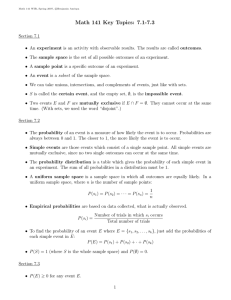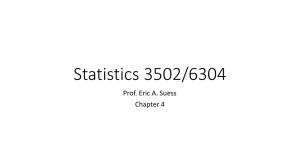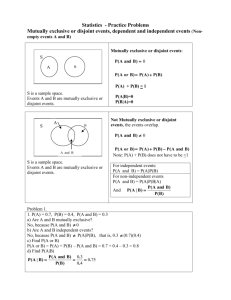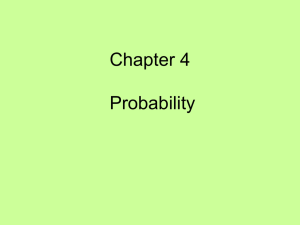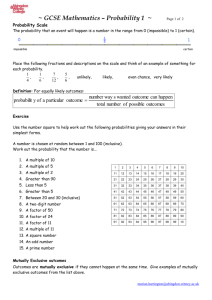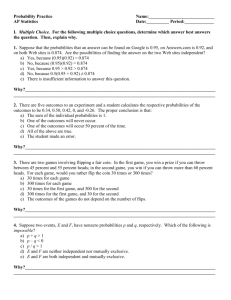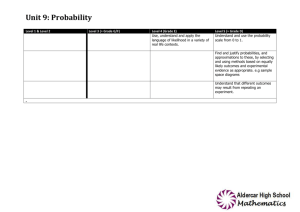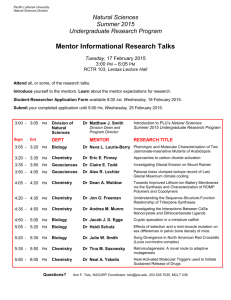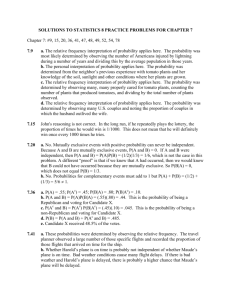Unit 5 Review
advertisement
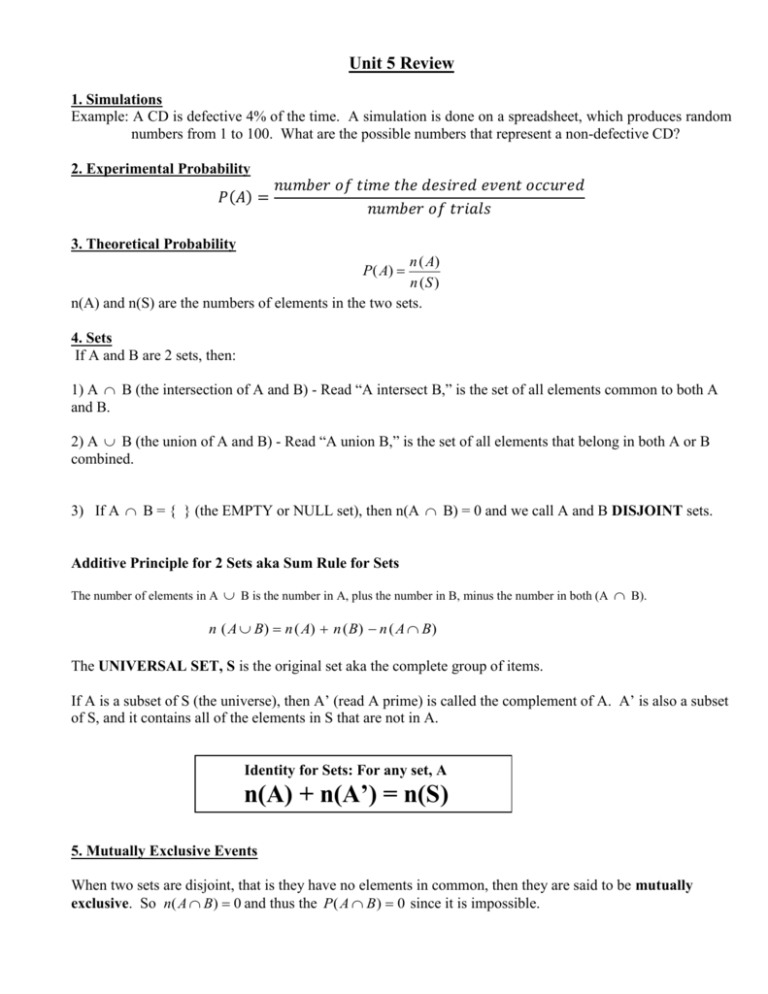
Unit 5 Review
1. Simulations
Example: A CD is defective 4% of the time. A simulation is done on a spreadsheet, which produces random
numbers from 1 to 100. What are the possible numbers that represent a non-defective CD?
2. Experimental Probability
𝑃 (𝐴 ) =
𝑛𝑢𝑚𝑏𝑒𝑟 𝑜𝑓 𝑡𝑖𝑚𝑒 𝑡ℎ𝑒 𝑑𝑒𝑠𝑖𝑟𝑒𝑑 𝑒𝑣𝑒𝑛𝑡 𝑜𝑐𝑐𝑢𝑟𝑒𝑑
𝑛𝑢𝑚𝑏𝑒𝑟 𝑜𝑓 𝑡𝑟𝑖𝑎𝑙𝑠
3. Theoretical Probability
n ( A)
n (S )
n(A) and n(S) are the numbers of elements in the two sets.
P ( A)
4. Sets
If A and B are 2 sets, then:
1) A B (the intersection of A and B) - Read “A intersect B,” is the set of all elements common to both A
and B.
2) A B (the union of A and B) - Read “A union B,” is the set of all elements that belong in both A or B
combined.
3) If A B = { } (the EMPTY or NULL set), then n(A B) = 0 and we call A and B DISJOINT sets.
Additive Principle for 2 Sets aka Sum Rule for Sets
The number of elements in A B is the number in A, plus the number in B, minus the number in both (A B).
n ( A B) n ( A) n ( B) n ( A B)
The UNIVERSAL SET, S is the original set aka the complete group of items.
If A is a subset of S (the universe), then A’ (read A prime) is called the complement of A. A’ is also a subset
of S, and it contains all of the elements in S that are not in A.
Identity for Sets: For any set, A
n(A) + n(A’) = n(S)
5. Mutually Exclusive Events
When two sets are disjoint, that is they have no elements in common, then they are said to be mutually
exclusive. So n( A B) 0 and thus the P ( A B ) 0 since it is impossible.
Summary: Additive Principle for Probabilities of Mutually Exclusive Events aka Sum Rule for Chance
When Events A and B are Mutually Exclusive.
P( A B) P( A) P( B)
Use for “Either / Or” situations.
Additive Principle for Probabilities aka Sum Rule for Chance
P( A B) P( A) P( B) P( A B)
6. Conditional Probability
𝑃(𝐴|𝐵) =
𝑃(𝐴 ∩ 𝐵)
𝑃(𝐵)
Probability of event A, given B.
7. Independent Events
When 2 events, A and B are independent, the probability of both events occurring is given by the formula:
P( A B) P( A ) P( B )
This product rule for independent events applies to 3 independent sets as well.
The Fundamental Counting Principal
The total number of outcomes is the product of the possible outcomes at each step in the sequence. i.e. if a
first action can be performed in ‘a’ ways, and the second in ‘b’ ways, and the third in ‘c’ ways, then these
actions can be performed together in a b c ways.
Ex 1 A student has a 90% probability of making it to class on time if he catches his regular bus, but only a
30% probability of being on time if he misses it. He knows that he misses his regular bus 15% of the time.
a) Draw the probability tree diagram that shows all possible outcomes for this situation. Label the branches
of your tree with the appropriate probabilities.
b) What is the probability that he will be late for class?
Ex 2: Three hundred and twelve senior students have enrolled in at least one Grade 12 University course.
69 are in Chemistry
210 are in Physics
74 are in Biology
50 are in Chemistry & Physics
30 are in Physics & Biology
10 are in Biology & Chemistry
8 are in Chemistry, Biology, & Physics
a) Use a Venn diagram to represent this situation
b) Determine the number of seniors who take Grade 12U courses but do not take Grade 12U science
courses.
Review:
Pg. 268: #2,3,5a-c,e,9,10a-d
Pg. 270: #1,2,7a
Pg. 248: #13a,15
